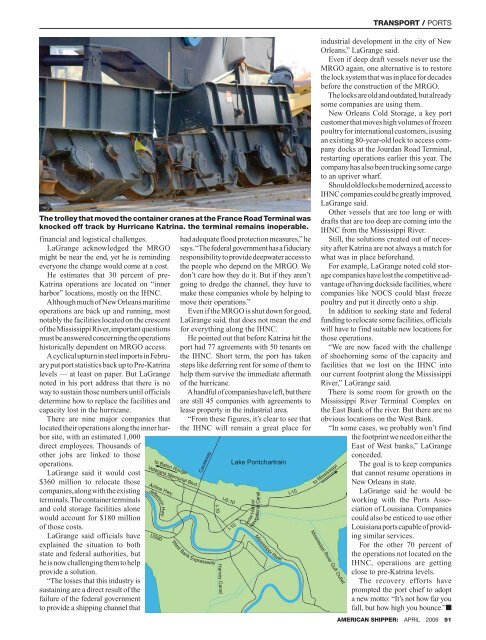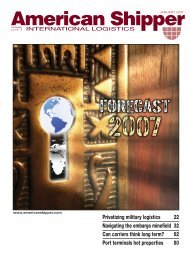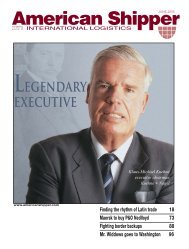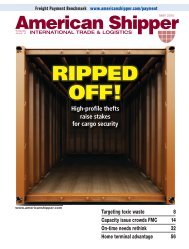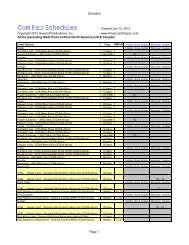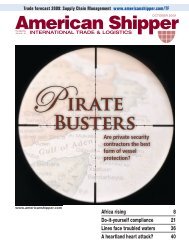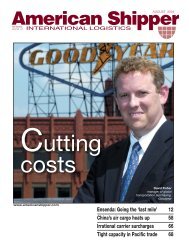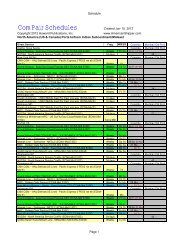TRANSPORT / PORTSofficials there to examine the port’s businessmodel.“Sacramento had a reason to want toassociate with us,” King said. “And we’vealways thought that was in our sphere. We’vethought about using the Central Valley topromote logistical support.”While the port has yet to decide what todo with its acres of undeveloped land, Lukensaid that since it’s currently zoned for industrialuse, he expects that West Sacramentowould keep it zoned that way.Which means the area would be primedto become a mini-distribution hub for inland-boundcargo and outbound cargo fromCalifornia’s Central Valley.And so the linkup should particularlyappeal to shippers and transportation companiesin that sense. Barging containersgives logistics specialists and shippers anoption that hasn’t existed for cargo arrivingin, or headed to, Oakland. While trucktraffic between Oakland and Sacramentoisn’t the nightmare that it is out of the portsof Long Beach and Los Angeles, it’s gettingworse and is a significant worry forofficials there.The prospect of barging containersbetween the two ports — in essence usingSacramento as an inland port — makessense particularly if it cuts down on emptycontainer loads traveling Interstate 80 betweenthe two cities, King said.“If there’s an opportunity to provide exchangeof containers so that they don’t returnempty to the Port of Oakland, then I thinkthat improves our competitiveness, cuts costsand helps environmentally,” he said.Sulpizio agreed.“We’d obviously be looking to the containerbarge service to relieve pressure onthe 80,” he said. “It allows them to shuttlecontainers immediately off the vessel to abarge, which clears up terminal space. Itdefinitely has the benefit of reducing trafficon I-80 and the barges, I believe, will haveless overall emissions per ton (of cargo)than trucks.”The products that could be barged toand from Oakland via Sacramento includeanything that could fit in a container — fromelectronics to exports of agriculture fromCalifornia’s farm-laden interior.Meanwhile, Sulpizio said Sacramento canhandle an influx of distribution centers andcontainers from the coast.“Sacramento is a fairly significant transportationregion,” Sulpizio said. “We’veactually been building on a goods movementnetwork infrastructure over time. Sacramentosits on the intersection of interstates5 and 80 and the port is a quarter-milefrom that intersection. You can take the 5all the way to Mexico and the 80 as a land90 AMERICAN SHIPPER: APRIL 2006“Everybody rightnow is excited aboutthe opportunity. We’vegot stars in our eyes.”Ray Kinggeneral managerof marketing, maritimedivision,Port of Oaklandbridge to Chicago, if you were so inclined.And the rail connections aren’t that bad.We’re well-placed and we’ve got availableland that would attract major warehouseoperators.”But he cautioned: “It would likely takesome modest capital investment to buildthe barge-container handling facilities sothere are some hurdles that need to beovercome.”Private firms will, no doubt, look longand hard at the port’s financial troubles thelast five years.In August, when <strong>American</strong> <strong>Shipper</strong> spokewith Sulpizio about press reports that theport was near bankruptcy, he said the rumorswere unfounded.“When people talk about running out ofcash, that assumes the do-nothing scenario,”he said.The port is also looking to sell a 33-acrepiece of property to raise $7 million. Thereare currently 150 acres in the terminal and500 acres of undeveloped land owned bythe port.“It’s a bridging strategy,” Sulpizio said.“No business can continue to sell off assetsas a long-term strategy.”But in February, the Sacramento Beereported that Sacramento had sold a 30-acreparcel of its land for $6.6 million to staveoff bankruptcy, a move that gave the portsome breathing room while seeing whereits future with Oakland lies.The newspaper also said Sacramento hasdebts of $13 million, reserves of $8 millionand lost $800,000 in fiscal year 2005.So the Port of Sacramento seems to havefound its safe harbor in the storm, whileOakland seems to have found a way to addressgrowth and environmental issues asterminal space shrinks.“You’ve got to find better ways to useexisting infrastructure,” Sulpizio said. “Andthis is a good way.”■‘Give up the MRGO’Closing of Mississippi River Gulf Outlet would forcerelocation of critical New Orleans infrastructure.Gary LaGrange, president and chiefexecutive officer of the Port of NewOrleans, laid it out in this year’sannual State of the Port address: “We areready to give up the MRGO.”LaGrange was referring to the MississippiRiver Gulf Outlet, the man-made shippingchannel that provides ocean carriers witha direct connection between New Orleansand the Gulf of Mexico, and serves as thehome for major terminals, warehouses andwaterfront businesses.The MRGO, often referred to as the Mr.Go, has long been seen as a blessing and acurse. The benefits — faster access to theGulf and a location away from city streetsthat offered more room for modern shippingoperations — led to its constructionin the 1960s.But navigation benefits turned to navigationimpediments when hurricane hit inyears past, causing the waterway to silt upand become inaccessible for large ships.BY JIM DOWWith key facilities like the France Roadand Jourdan Road terminals normally accessby the MRGO, that created ongoingproblems.But those problems paled when HurricaneKatrina hit late last summer. The MRGO essentiallyturned into a funnel for the incomingstorm surge, leading to the breaches along theadjoining Inner Harbor Navigational Channel(IHNC) that flooded the city’s Lower NinthWard area.The flooding led to calls for the permanentclosure of the MRGO. The state legislaturetook an important step toward that option inFebruary, when it passed a resolution callingfor Congress to close the waterway. Thefederal government, which controls access toports, will have the final say on the matter.For local shipping interests, already facedwith the challenge of bouncing back fromthe damage Katrina wreaked on both infrastructureand the economy, the prospectsof closing the MRGO present incredible
TRANSPORT / PORTSThe trolley that moved the container cranes at the France Road Terminal wasknocked off track by Hurricane Katrina. the terminal remains inoperable.financial and logistical challenges.LaGrange acknowledged the MRGOmight be near the end, yet he is remindingeveryone the change would come at a cost.He estimates that 30 percent of pre-Katrina operations are located on “innerharbor” locations, mostly on the IHNC.Although much of New Orleans maritimeoperations are back up and running, mostnotably the facilities located on the crescentof the Mississippi River, important questionsmust be answered concerning the operationshistorically dependent on MRGO access.A cyclical upturn in steel imports in Februaryput port statistics back up to Pre-Katrinalevels — at least on paper. But LaGrangenoted in his port address that there is noway to sustain those numbers until officialsdetermine how to replace the facilities andcapacity lost in the hurricane.There are nine major companies thatlocated their operations along the inner harborsite, with an estimated 1,000direct employees. Thousands ofother jobs are linked to thoseoperations.LaGrange said it would cost$360 million to relocate thosecompanies, along with the existingterminals. The container terminalsand cold storage facilities alonewould account for $180 millionof those costs.LaGrange said officials haveexplained the situation to bothstate and federal authorities, buthe is now challenging them to helpprovide a solution.“The losses that this industry issustaining are a direct result of thefailure of the federal governmentto provide a shipping channel thathad adequate flood protection measures,” hesays. “The federal government has a fiduciaryresponsibility to provide deepwater access tothe people who depend on the MRGO. Wedon’t care how they do it. But if they aren’tgoing to dredge the channel, they have tomake these companies whole by helping tomove their operations.”Even if the MRGO is shut down for good,LaGrange said, that does not mean the endfor everything along the IHNC.He pointed out that before Katrina hit theport had 77 agreements with 50 tenants onthe IHNC. Short term, the port has takensteps like deferring rent for some of them tohelp them survive the immediate aftermathof the hurricane.A handful of companies have left, but thereare still 45 companies with agreements tolease property in the industrial area.“From these figures, it’s clear to see thatthe IHNC will remain a great place forindustrial development in the city of NewOrleans,” LaGrange said.Even if deep draft vessels never use theMRGO again, one alternative is to restorethe lock system that was in place for decadesbefore the construction of the MRGO.The locks are old and outdated, but alreadysome companies are using them.New Orleans Cold Storage, a key portcustomer that moves high volumes of frozenpoultry for international customers, is usingan existing 80-year-old lock to access companydocks at the Jourdan Road Terminal,restarting operations earlier this year. Thecompany has also been trucking some cargoto an upriver wharf.Should old locks be modernized, access toIHNC companies could be greatly improved,LaGrange said.Other vessels that are too long or withdrafts that are too deep are coming into theIHNC from the Mississippi River.Still, the solutions created out of necessityafter Katrina are not always a match forwhat was in place beforehand.For example, LaGrange noted cold storagecompanies have lost the competitive advantageof having dockside facilities, wherecompanies like NOCS could blast freezepoultry and put it directly onto a ship.In addition to seeking state and federalfunding to relocate some facilities, officialswill have to find suitable new locations forthose operations.“We are now faced with the challengeof shoehorning some of the capacity andfacilities that we lost on the IHNC intoour current footprint along the MississippiRiver,” LaGrange said.There is some room for growth on theMississippi River Terminal Complex onthe East Bank of the river. But there are noobvious locations on the West Bank.“In some cases, we probably won’t findthe footprint we need on either theEast of West banks,” LaGrangeconceded.The goal is to keep companiesthat cannot resume operations inNew Orleans in state.LaGrange said he would beworking with the Ports Associationof Louisiana. Companiescould also be enticed to use otherLouisiana ports capable of providingsimilar services.For the other 70 percent ofthe operations not located on theIHNC, operations are gettingclose to pre-Katrina levels.The recovery efforts haveprompted the port chief to adopta new motto: “It’s not how far youfall, but how high you bounce.” ■AMERICAN SHIPPER: APRIL 2006 91


